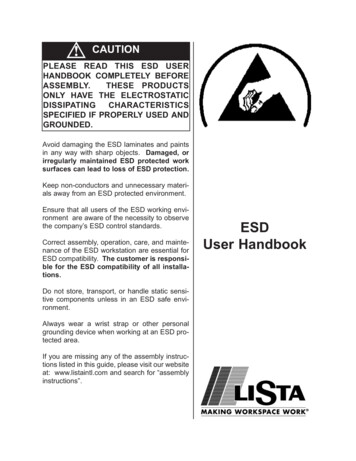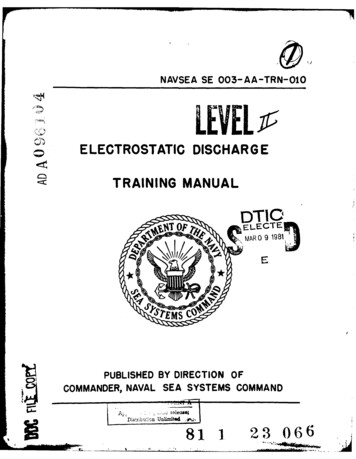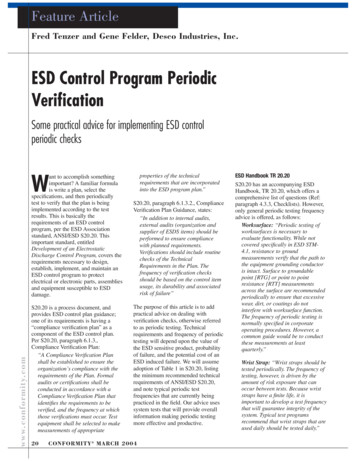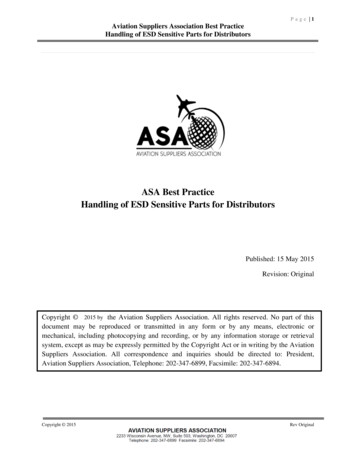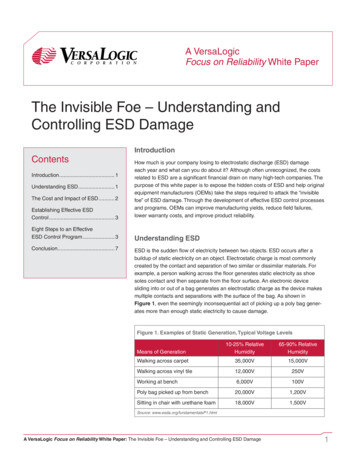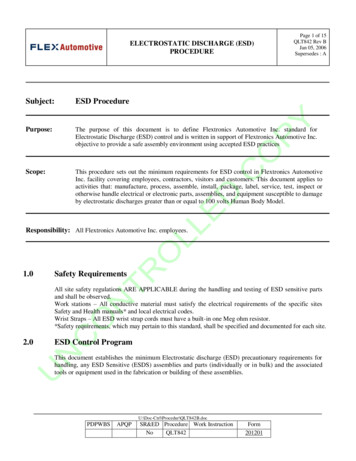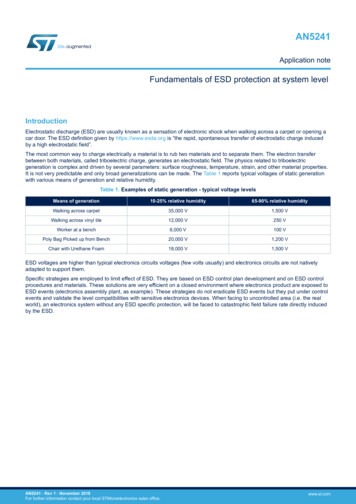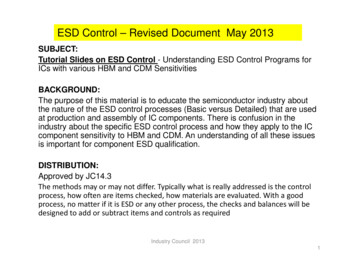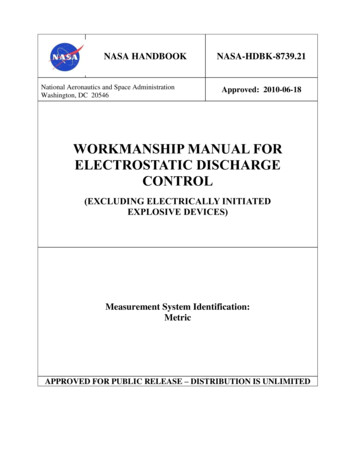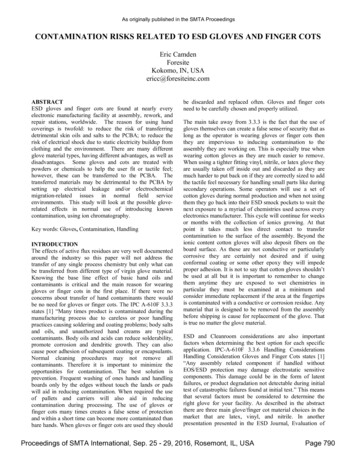
Transcription
As originally published in the SMTA ProceedingsCONTAMINATION RISKS RELATED TO ESD GLOVES AND FINGER COTSEric CamdenForesiteKokomo, IN, USAericc@foresiteinc.comABSTRACTESD gloves and finger cots are found at nearly everyelectronic manufacturing facility at assembly, rework, andrepair stations, worldwide. The reason for using handcoverings is twofold: to reduce the risk of transferringdetrimental skin oils and salts to the PCBA; to reduce therisk of electrical shock due to static electricity buildup fromclothing and the environment. There are many differentglove material types, having different advantages, as well asdisadvantages. Some gloves and cots are treated withpowders or chemicals to help the user fit or tactile feel;however, these can be transferred to the PCBA. Thetransferred materials may be detrimental to the PCBA bysetting up electrical leakage and/or electrochemicalmigration-related issues in normal field serviceenvironments. This study will look at the possible gloverelated effects in normal use of introducing knowncontamination, using ion chromatography.Key words: Gloves, Contamination, HandlingINTRODUCTIONThe effects of active flux residues are very well documentedaround the industry so this paper will not address thetransfer of any single process chemistry but only what canbe transferred from different type of virgin glove material.Knowing the base line effect of basic hand oils andcontaminants is critical and the main reason for wearinggloves or finger cots in the first place. If there were noconcerns about transfer of hand contaminants there wouldbe no need for gloves or finger cots. The IPC A-610F 3.3.3states [1] “Many times product is contaminated during themanufacturing process due to careless or poor handlingpractices causing soldering and coating problems; body saltsand oils, and unauthorized hand creams are typicalcontaminants. Body oils and acids can reduce solderability,promote corrosion and dendritic growth. They can alsocause poor adhesion of subsequent coating or encapsulants.Normal cleaning procedures may not remove allcontaminants. Therefore it is important to minimize theopportunities for contamination. The best solution isprevention. Frequent washing of ones hands and handlingboards only by the edges without touch the lands or padswill aid in reducing contamination. When required the useof pallets and carriers will also aid in reducingcontamination during processing. The use of gloves orfinger cots many times creates a false sense of protectionand within a short time can become more contaminated thanbare hands. When gloves or finger cots are used they shouldbe discarded and replaced often. Gloves and finger cotsneed to be carefully chosen and properly utilized.The main take away from 3.3.3 is the fact that the use ofgloves themselves can create a false sense of security that aslong as the operator is wearing gloves or finger cots thenthey are impervious to inducing contamination to theassembly they are working on. This is especially true whenwearing cotton gloves as they are much easier to remove.When using a tighter fitting vinyl, nitrile, or latex glove theyare usually taken off inside out and discarded as they aremuch harder to put back on if they are correctly sized to addthe tactile feel necessary for handling small parts like duringsecondary operations. Some operators will use a set ofcotton gloves during normal production and when not usingthem they go back into their ESD smock pockets to wait thenext exposure to a myriad of chemistries used across everyelectronics manufacturer. This cycle will continue for weeksor months with the collection of ionics growing. At thatpoint it takes much less direct contact to transfercontamination to the surface of the assembly. Beyond theionic content cotton gloves will also deposit fibers on theboard surface. As these are not conductive or particularlycorrosive they are certainly not desired and if usingconformal coating or some other epoxy they will impedeproper adhesion. It is not to say that cotton gloves shouldn’tbe used at all but it is important to remember to changethem anytime they are exposed to wet chemistries inparticular they must be examined at a minimum andconsider immediate replacement if the area at the fingertipsis contaminated with a conductive or corrosion residue. Anymaterial that is designed to be removed from the assemblybefore shipping is cause for replacement of the glove. Thatis true no matter the glove material.ESD and Cleanroom considerations are also importantfactors when determining the best option for each specificapplication. IPC-A-610F 3.3.6 Handling ConsiderationsHandling Consideration Gloves and Finger Cots states [1]“Any assembly related component if handled withoutEOS/ESD protection may damage electrostatic sensitivecomponents. This damage could be in the form of latentfailures, or product degradation not detectable during initialtest of catastrophic failures found at initial test.” This meansthat several factors must be considered to determine theright glove for your facility. As described in the abstractthere are three main glove/finger cot material choices in themarket that are latex, vinyl, and nitrile. In anotherpresentation presented in the ESD Journal, Evaluation ofProceedings of SMTA International, Sep. 25 - 29, 2016, Rosemont, IL, USAPage 790
Materials for Cleanliness and ESD Protective Properties [2]“ESD protective materials are desirable too since they haveat least one of the following properties: they prevent thegeneration of static, dissipate electrostatic charges, orprovide shielding from electrostatic fields/ESD. Moreover,an ESD protective material attracts less particulatecontamination to its surface than an insulative material sincefewer charges are generated and accumulated on itssurface”. In some cases this is as important as any otherconsideration, especially when working with wafer levelfabrication. Even the smallest bit of foreign debris can bedetrimental to some processes. The gloves tested in thisstudy show varying levels of resistance to attract foreign,fibrous material according to the paper in ESD Journal. Thegloves in this study are focusing on only ioniccontamination levels.TEST AREAS AND SAMPLING TECHNIQUEI have noticed during normal operation on an assembly floorthat direct contact with power and ground pads is notimpossible but also isn’t always easily achieved. The waythe boards were tested for this study would representmishandling at a bare board level that can impact thecleanliness going forward. If this is a no-clean flux process,that isn’t being washed, there will be no way to remove theresidues from the surface. These salts and oils will remainhydroscopic and act as a barrier for epoxy/coating adhesion.If the process includes an effective wash process there is achance that the residues will be removed but the idea is toprocess the assemblies with the least amount ofcontamination added as you go along in case there are issueswith cleaning process. Samples were produced using newlatex, vinyl, and nitrile gloves in a dry state as well as afteran application of IPA to simulate a rework/repair bench thatuses solvent based cleaners. Each glove was worn fresh andthen pressed against a comb pattern on an Umpire 2 testboard, see Fig. 1, ten times for one second per touch. Eachboard also has one pattern with bare thumb contact as acontrol and uses the same ten touch method. A total of 10replicates were processed for each condition and the ICtables show the average of all the data.The analysismethod used was ion chromatography that will determinethe exact type and amount of ionic contaminationtransferred from glove to board. The risk of human skinsalts and oils has been researched by many sources and mosthave the same general result, it isn’t ideal and can bedetrimental. The natural sodium chloride and oils that arepresent can induce electrical leakage and issues withadhesion. You also have to consider the presence of lotions,hand sanitizers, and other unknown foreign materials as theycan have the same if not more exaggerated symptoms as thenatural salts/oils. For this test no special consideration wastaken when performing the bare skin test. This wasconsidered a normal scenario when mimicking a productionfloor on any given work day. The analytical technique usedwas ion chromatography per IPC-TM-650 2.3.28b utilizingautomated localized extraction. I.C. results yield results thatcan be traced back to specific material signatures from eachsurface tested, in this case the glove/thumb contaminationon the bare copper pad sites. The main anion and cationspecies tested for include what are considered some of themost detrimental such as chloride, sulfate, and sodium fortheir conductive properties as well as calcium for theinsulative properties that will affect adhesion. Chloride isone of the more detrimental materials found on printedcircuit assemblies. Chlorides can come from a variety ofsources, but is most often attributable to flux residues.Chlorides will generally initiate and propagateelectrochemical failure mechanisms, such as metalmigration and electrolytic corrosion, when combined withwater vapor and an electrical potential. The amount ofallowable chloride on a bare board is difficult to assess. Ifthe board enters an assembly process that incorporatescleaning, then a higher level of chloride can be tolerated. Ifthe bare board enters an assembly process void of cleaning(no-clean), then a more stringent level of acceptablechloride is necessary. Sulfate, when present in sufficientquantity, can be harmful to electronic assemblies. Sulfatescan come from a variety of sources, such as contact withsulfur-bearing papers or plastics, acid processes infabrication. However, most often these residues come fromtap water rinsing / cleaning processes. When sulfate levelsstart rising appreciably above 3.0 µg/in2, we look for asulfate-bearing chemical in the process, such assodium/ammonium per sulfate or sulfuric acid. Inelectronics manufacturing, sodium is found in some fluxes,as the counter ion to the acid activator such as sodiumsuccinate. It is also found in solder mask as absorbedresidues and can be conductive through or on top of themask. Levels less than 3.0 µg/in2 have shown good fieldperformance and good SIR test results. Calcium is typicallyfound in the solder mask as fillers and rarely come intosolution or cause electrical leakage and corrosion problems.For the purpose of this study the calcium can be from glovesthat are powdered on the inside. All ion chromatographytesting is performed using a Dionex ICS 3000 system withChromeleon software. Reference control and blank tests areperformed before the start of testing and controls are runafter every 10 test samples. The system is calibrated usingNIST-traceable standards utilizing six-point calibration. A1.5mL sample of each extracted solution is analyzed using asodium bicarbonate and sodium carbonate eluent.Proceedings of SMTA International, Sep. 25 - 29, 2016, Rosemont, IL, USAPage 791
Pad #1 Bare TouchFigure 3. Nitrile GlovePad #3 IPA GloveFigure 4. Vinyl GlovePad #2 Dry GloveFigure 1. Umpire 2 Test Board TestFigure 5. Bare thumb application for all control samples onPad #1Figure 2. Latex GloveProceedings of SMTA International, Sep. 25 - 29, 2016, Rosemont, IL, USAPage 792
Figure 8. IPA glove process on pad #3Figure 6. Dry glove application for all samples on Pad #2Figure 2 shows the latex glove, figure 3 shows the nitrileglove, and figure 4 shows the vinyl glove used for the study.Figure 5 shows the bare thumb process. Figure 6 shows thedry glove transfer test. Figure 7 shows the IPA to gloveapplication with figure 8 showing the IPA exposed glove topad application. The photos taken show the different glovetypes but so apply to all types individually as well. Test pad1 is the bare thumb contact, test pad 2 is the dry glovecontact, and test pad 3 is the IPA gloved contact. The IPAcontact consist of rolling a gloved thumb on a clean roomwipe, Figure 3, that has been soaked in lab grade IPAsimilar to what is found in the bottle top IPA/solventdispenser. This was done between each one second touch topad 3.Figure 7. IPA glove application process with clean wipesoaked with IPA.Sample one results, Tables 1 and 2, consist of an Umpire 2test board without being subjected to any touching fromeither bare or gloved finger. This is the baseline data andhas been subtracted from the I.C. results on eachconditioned sample. All results are the average of 10 samplereplicated processed for each sample type.Table 1. Bare Copper Pad Baseline Anionsall values in ug/in2Sam ple DescriptionForesite recommended limits forBare Boards-AnionsIon Chrom atography (Dionex ICS 3000 at Foresite) n/a notFluo ride A cetate Fo rmate Chlo ride B ro mide Nitrate32.52.52.02.52.5SulfateWOA3.0n/aID123No Touch Pad 1No Touch Pad 2No Touch Pad 30.08 0.04 0.040.18 0.45 0.040.37 0.40 0.22Proceedings of SMTA International, Sep. 25 - 29, 2016, Rosemont, IL, USA0.340.240.100.06 0.24 0.91 1.190.09 0.26 1.19 1.380.19 0.12 1.00 0.26Page 793
Table 2. Bare Copper Pad Baseline Cationswas not transferred in greater amounts after the IPAapplication shows that the material is not soluble.all values in ug/in2Sam ple De s criptio Lithium So dium A mmo nium P o tassium M agnesium CalciumForesite recommended limitsf or Bare 280.290.070.160.360.330.060.460.691.47ID123No Touch Pad 1No Touch Pad 2No Touch Pad 3The second glove type is the nitrile material. The blacknitrile gloves were all processed the same and used freshfrom the packaging.Table 5. Nitrile Anion ResultsNo Glove BaselineIon Chrom atography (Dionex ICS 3000 aall values in ug/in2Sam ple DescriptionFluo ride A cetate Fo rmate Chlo rideForesite recommended limits f orBare Boards-Anions4.0032.52.5B ro mide n/a2.5ID2.00120.00Cl‐SO4‐2Na Bare Touch Pad 13Ca 2Nitrile Bare Pad 1Nitrile Dry Pad 2Nitrile Pad 30.540.090.250.75 0.070.02 0.120.11 0.690.13 0.56 0.190.28 0.98 0.130.33 0.49 0.37Table 6. Nitrile Cation ResultsBare Touch Pad 2all values in ug/in2Bare Touch Pad 3Sam ple De s criptionForesite recommended limits f orBare Boards-CationLithiumSo diumA mmo nium P o tassium M agnesium 0.180.350.520.230.198.410.761.26IDThe first conditioned test board is the latex sample. Testpads 1, 2, and 3 were all conditioned as mentioned before.The IC test results are shown in Tables.123Nitrile Bare Pad 1Nitrile Dry Pad 2Nitrile Pad 3Table 3. Latex Anion ResultsIon Chrom atography (Dionex ICS 3000 aall values in ug/in2Sam ple Descriptio Fluo ride A cetate Fo rmate Chlo ride B ro mide NitrateForesite recommended limitsfor Bare 0.840.060.770.690.030.020.723ID123Latex Bare Pad 1 0.34Latex Dry Pad 2 0.13Latex IPA Pad 3 0.19Table 4. Latex Cation Resultsall values in ug/in2Sam ple De scriptionForesite recommended limits f or BareBoards-CationLithiumSo dium22A mmo nium P o tassium M agnesium 130.020.140.560.031.3014.013.90ID123Latex Bare Pad 1Latex Dry Pad 2Latex IPA Pad 3The results of the nitrile samples show low levels of ionicson pads 2 and 3 when averaged over 10 samples of eachcondition. There is very little contamination transferred aswith the latex samples.The final glove material choice tested is vinyl. One majordifference in vinyl is that it does not stretch as much asnitrile and latex which lessens the tactile quality of a goodlaboratory glove.Table 7. Vinyl Anion ResultsIon Chrom atography (Dionex ICS 3000 aall values in ug/in2Sam ple DescriptionForesite recommended limits forBare Boards-AnionsFluo ride A cetate Fo rmate Chlo ride32.52.5B ro mide 13SulfateWOA3.0n/aID1The latex glove samples show some elevated averages ofsodium and calcium on the dry pad sample and not on theIPA sample. This is a function of material being present onthe as received glove samples transferring somecontamination that is being wiped off of the glove with thewiping of the IPA soaked clean room wipe. As the material23Vinyl Bare Pad 1Vinyl Dry Pad 2Vinyl IPA Pad 30.420.400.130.65 0.180.64 0.670.16 0.41Proceedings of SMTA International, Sep. 25 - 29, 2016, Rosemont, IL, USA0.26 0.211.10 1.000.24 1.06Page 794
Table 8. Vinyl Cations Resultsreliability but it isn’t from the glove itself but more likelythe manner in which they are being worn.all values in ug/in2Sam ple Des criptionForesite recommended limits f or BareBoards-CationLithiumSo dium22A mmo nium P o tassium M agnesium 380.350.201.320.302.983.272.64ID123Vinyl Bare Pad 1Vinyl Dry Pad 2Vinyl IPA Pad 3Future WorkSurface insulation resistance testing was to be done withthis paper but due to a myriad of errors the data was notuseable. Reproducing those samples for SIR/ECM should beadded to this report. More finishes than bare copper shouldalso be considered to determine if the effect of the glovematerials on different surface finishes is vastly different.Conformal coating can still be added to the current samplesas tested to determine effect on adhesion.REFERENCES[1] IPC-A-610F Acceptability of Electronic Assemblies3.3.3 Handling Consideration -Contamination and 3.3.6Handling Consideration-Gloves and Finger CotsThe total averages of the vinyl samples show elevated levelsof sodium and ammonium. The level of calcium is alsoelevated more so with the dry touch than the IPAapplication touch due to the IPA clean wipe cleaning theglove. At the same time that means that the contact with theIPA does not degrade any of the glove materials to the pointwhere the ionics are greatly increased after exposure andapplication on the PCB surface.[2] ESD Journal- Evaluation of Material for Cleanliness andESD Protective Properties Tom Lesniewksi and Kenn YatesCONCLUSIONSChoosing a protective glove for the production floor is acritical decision and all variable need to be considered. IfESD is not a special consideration, for PCB manufacturing,then all you need to consider is cleanliness as salts and oilscan induce an insulative barrier that may inhibit propersolder flow. If they are to be used in an assembly housethere needs to be a balance between ESD protection andcleanliness. The results of this study suggest that overall thevinyl gloves have the least total amount of ionic content. Allthree are at a low risk of introducing enough contaminationto facilitate electrical leakage and/or electrochemicalmigration. The study was a worst case scenario withrepeated exposure of various gloves to a single area. Innormal production the risk for causing detrimental damagecomes from handling of chemistries and then handlingassemblies. When process chemistries come into contactwith gloves it takes very little to transfer those residues tothe surface of an assembly. The IPC-A-610F [1] states in3.3.1 “Touch only the edges away from any edge connectortabs. Where a firm grip on the board is required due to anymechanical assembly procedure, gloves meeting EOS/ESDrequirements may be required. These principles areespecially critical when no-clean processes are employed”This should always be part of any employee training forhandling of PCBs/PCBAs. One best practice is to trainemployees to properly handle the samples as if they werenot going to be wearing gloves, and then wear gloves.Handling is a very real threat to the cleanliness andProceedings of SMTA International, Sep. 25 - 29, 2016, Rosemont, IL, USAPage 795
bare hands. When gloves or finger cots are used they should be discarded and replaced often. Gloves and finger cots need to be carefully chosen and properly utilized. The main take away from 3.3.3 is the fact that the use of gloves themselves can create a false sense of security that as long as the operator is wearing gloves or finger cots then
